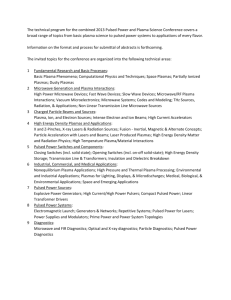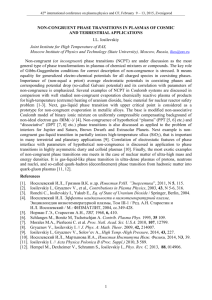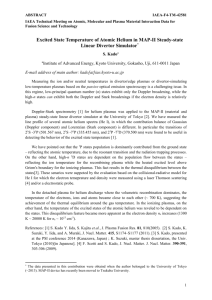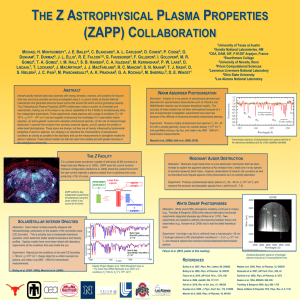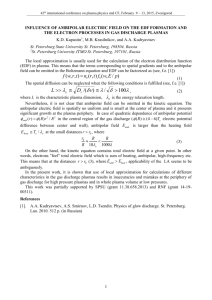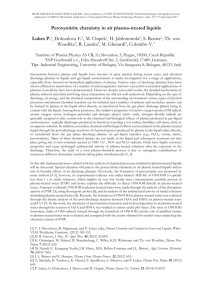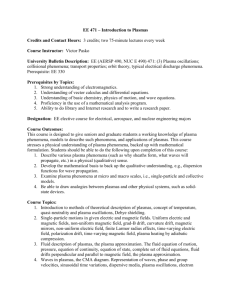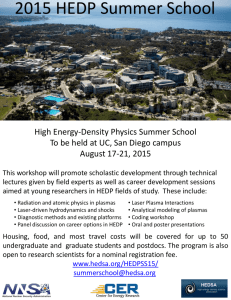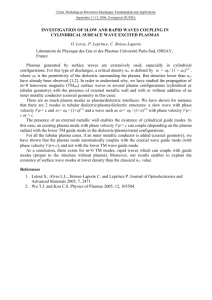ECE523 Outline
advertisement
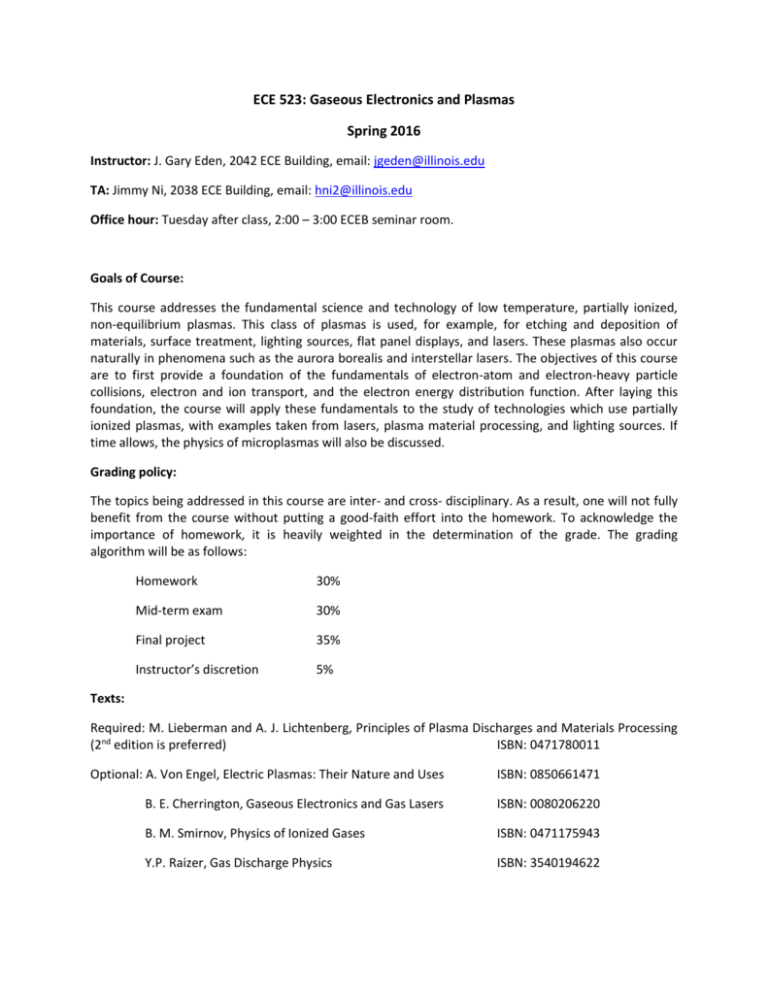
ECE 523: Gaseous Electronics and Plasmas Spring 2016 Instructor: J. Gary Eden, 2042 ECE Building, email: jgeden@illinois.edu TA: Jimmy Ni, 2038 ECE Building, email: hni2@illinois.edu Office hour: Tuesday after class, 2:00 – 3:00 ECEB seminar room. Goals of Course: This course addresses the fundamental science and technology of low temperature, partially ionized, non-equilibrium plasmas. This class of plasmas is used, for example, for etching and deposition of materials, surface treatment, lighting sources, flat panel displays, and lasers. These plasmas also occur naturally in phenomena such as the aurora borealis and interstellar lasers. The objectives of this course are to first provide a foundation of the fundamentals of electron-atom and electron-heavy particle collisions, electron and ion transport, and the electron energy distribution function. After laying this foundation, the course will apply these fundamentals to the study of technologies which use partially ionized plasmas, with examples taken from lasers, plasma material processing, and lighting sources. If time allows, the physics of microplasmas will also be discussed. Grading policy: The topics being addressed in this course are inter- and cross- disciplinary. As a result, one will not fully benefit from the course without putting a good-faith effort into the homework. To acknowledge the importance of homework, it is heavily weighted in the determination of the grade. The grading algorithm will be as follows: Homework 30% Mid-term exam 30% Final project 35% Instructor’s discretion 5% Texts: Required: M. Lieberman and A. J. Lichtenberg, Principles of Plasma Discharges and Materials Processing (2nd edition is preferred) ISBN: 0471780011 Optional: A. Von Engel, Electric Plasmas: Their Nature and Uses ISBN: 0850661471 B. E. Cherrington, Gaseous Electronics and Gas Lasers ISBN: 0080206220 B. M. Smirnov, Physics of Ionized Gases ISBN: 0471175943 Y.P. Raizer, Gas Discharge Physics ISBN: 3540194622 ECE 523 Tentative Schedule- Spring 2016 Date Topics 1/19 1/21 2/16 2/18 Introduction, plasma application Qualitative characteristics of plasmas, plasma frequency, Debye length, electron density, conductivity Boltzmann’s equation Boltzmann’s equation (cont.), conservation equations Elastic collisions (momentum transfer, Coulombic, induced dipole) Inelastic collisions (electronic excitations, ionization, rotational and vibrational excitation) Cross-sections and rate coefficients Cross-sections and rate coefficients (cont.) experimental methods Electron transport, diffusion Diffusion (cont.) 2/23 2/25 Container interactions (sheath) Sheaths, Bohm criterion 3/1 3/3 Bohm criterion (cont.), thermionic emission Secondary electron emission, collisional Boltzmann equation Collisional Boltzmann equation (cont.), two-temperature approximation Langmuir probes Normal glow discharge, cathode fall equation, abnormal glow discharge, negative glow, positive column Midterm exam Arc discharge advantages, hollow cathode, electron-beam pumped discharge RF discharge advantages, sheath potentials, IV characteristics Ions in RF discharges, CCP, dielectric barrier discharges Magnetic fields in plasmas, ECRs, helicons Plasma procession (RIE, PECVD, Sputtering) Plasma light sources, high-pressure sodium lamps, mercury lamps Plasma display panels Lasers Lasers (cont.) Final presentations Final presentations (cont.) Reading day 1/26 1/28 2/2 2/4 2/9 2/11 3/8 3/10 3/15 3/17 3/29 3/31 4/5 4/7 4/12 4/14 4/19 4/21 4/26 4/28 5/3 5/5 Required Reading Lieberman 1.1 – 1.4 L 2.1 – 2.4 L 3.1 – 3.3 L 3.4, Appendix A L 8.1 – 8.3 Assignments HW 1 assigned HW 1 due, HW 2 assigned HW 2 due, HW 3 assigned L 5.1 L 5.2- 5.4 L 6.1 – 6.3 L 6.4 HW 3 due, HW 4 assigned HW 4 due, HW 5 assigned HW 5 due L 6.5 L 6.6 14.1 – 14.4 Final project assigned HW 6 assigned L 13.1, 13.2 15.1 – 16.3 HW 6 due Final paper due

